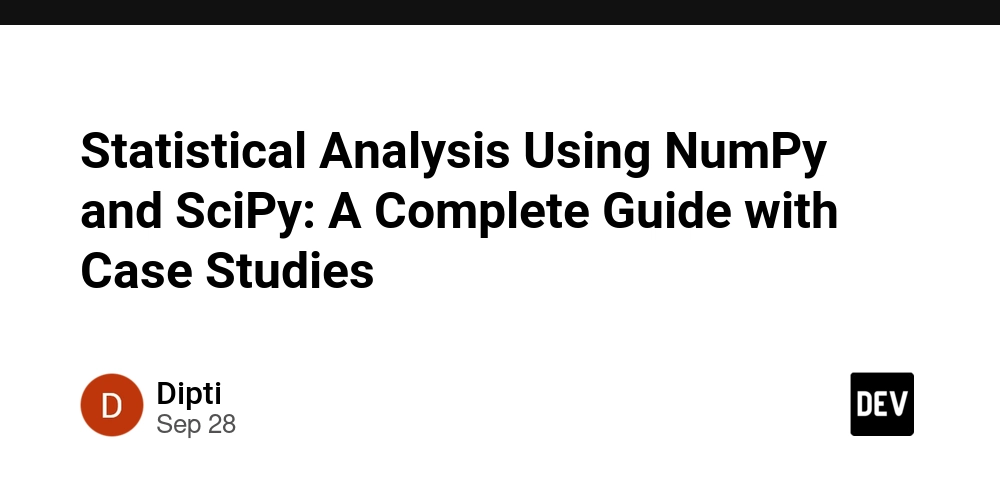Introduction
In today’s data-driven world, decision-making is no longer based on instinct alone. Businesses, researchers, and analysts depend on powerful statistical tools to make sense of massive amounts of data. Two of the most widely used Python libraries for statistical and numerical analysis are NumPy (Numerical Python) and SciPy (Scientific Python). Together, they form the backbone of scientific computing in Python and enable everything from simple descriptive statistics to complex scientific modeling.
While many people associate NumPy and SciPy with coding, the bigger picture lies in how they empower analysts to extract insights, validate hypotheses, and understand patterns in real-world data. This article explores their roles in statistical analysis, explains core concepts, and demonstrates practical business and research applications through real-world case studies.
What is NumPy?
NumPy, short for Numerical Python, is the foundation of numerical and scientific computing in Python. It offers a powerful data structure known as the array. Unlike Python lists, arrays are faster, more memory-efficient, and optimized for mathematical operations.
For example:
A business analyst processing millions of customer records will find NumPy arrays significantly faster than Python lists.
Researchers dealing with experimental results benefit from NumPy’s vectorized operations, which remove the need for looping through data manually.
Beyond arrays, NumPy includes functions for linear algebra, random number generation, transformations, and statistical analysis, making it indispensable for both exploratory and applied work.
What is SciPy?
SciPy builds on the foundation laid by NumPy. While NumPy focuses on arrays and efficient computation, SciPy provides specialized algorithms and statistical functions.
It includes modules for:
Optimization (finding best-fit parameters)
Integration (calculating areas under curves)
Signal processing (filtering, transformations)
Statistics (regression, hypothesis testing, probability distributions)
Together, NumPy and SciPy allow analysts to go from basic descriptive statistics to complex scientific analysis seamlessly.
Why Use NumPy and SciPy for Statistics?
The value of NumPy and SciPy lies not just in what they calculate, but in how they transform raw data into actionable insights.
Key benefits:
Speed and Efficiency – Large datasets can be processed within seconds.
Accuracy – The functions are rigorously tested and widely trusted in academia and industry.
Flexibility – They integrate with machine learning, data visualization, and business intelligence tools.
Breadth of Statistical Methods – From mean and median to skewness, kurtosis, and advanced probability distributions.
Core Statistical Functions
Statistical analysis can be divided into descriptive (summarizing the data) and inferential (drawing conclusions about a population from a sample). NumPy and SciPy provide tools for both.
- Measures of Central Tendency
Mean: Average value — useful in analyzing trends like average monthly sales.
Median: Middle value — more robust when data contains outliers, e.g., in salary analysis where a few executives earn disproportionately high amounts.
Mode: Most frequent value — helpful in categorical analysis, like identifying the most purchased product.
- Measures of Dispersion
Range: Spread between minimum and maximum values.
Variance and Standard Deviation: Show how tightly data is clustered around the mean. For example, two stores with the same average sales may differ in stability if one has a higher variance.
Interquartile Range (IQR): Used to detect outliers and variability in data distribution.
- Skewness
Skewness measures whether data leans left (negative) or right (positive). For example, income distribution in most countries is positively skewed: the majority earn around the median, while a few earn far more.
Real-World Case Studies
To better understand how NumPy and SciPy apply in practice, let’s explore real business and research scenarios.
Case Study 1: Retail Sales Performance
A large retail chain used NumPy and SciPy to analyze monthly sales data across 200 stores.
Challenge: While average monthly sales looked strong, leadership wanted to know why profits varied widely between stores.
Solution:
NumPy was used to calculate mean sales and standard deviation for each region.
SciPy functions were applied to test for statistical significance in differences between regions.
Insight: Stores located in urban areas had consistent sales (low variance), while rural stores had high fluctuations.
Impact: The company introduced region-specific promotions, reducing volatility in rural store performance.
Case Study 2: Healthcare Research
A hospital analyzed patient recovery times for two different treatments.
Challenge: Doctors needed to know whether treatment A truly led to faster recovery compared to treatment B.
Solution:
NumPy helped calculate the mean, median, and variance of recovery days.
SciPy provided tools for hypothesis testing (t-tests) to determine if differences between treatments were statistically significant.
Insight: Patients receiving treatment A recovered 2.5 days faster on average, and the difference was statistically significant.
Impact: The hospital adopted treatment A as the standard protocol, improving patient care and reducing costs.
Case Study 3: Banking and Credit Risk
A financial institution used statistical modeling to evaluate loan defaults.
Challenge: The bank needed to identify riskier borrowers and minimize defaults.
Solution:
NumPy arrays stored and processed millions of loan records.
SciPy functions analyzed skewness and IQR to detect income outliers.
Regression models tested relationships between borrower income, loan size, and repayment history.
Insight: Borrowers with highly variable income (high standard deviation) and large loans were at higher risk of default.
Impact: The bank refined credit policies, saving millions annually in potential losses.
Case Study 4: Telecom Customer Churn
A telecom company wanted to understand customer churn (when customers leave for competitors).
Challenge: Customer satisfaction surveys showed mixed results, and churn rates were rising.
Solution:
NumPy was used to calculate mean satisfaction scores and detect clusters of dissatisfied users.
SciPy tested correlations between churn and customer complaints.
Insight: Customers who reported frequent network issues were 3x more likely to churn, regardless of pricing.
Impact: The company invested in network infrastructure, leading to a measurable reduction in churn within six months.
Case Study 5: Education and Student Performance
A university used NumPy and SciPy to analyze student grades.
Challenge: The administration wanted to identify at-risk students.
Solution:
NumPy calculated mean, variance, and skewness of grades across subjects.
SciPy tested performance differences between students attending lectures regularly and those who didn’t.
Insight: Regular attendance correlated strongly with higher performance, with significant differences confirmed statistically.
Impact: The university introduced mandatory attendance policies, improving overall pass rates.
Broader Applications Across Industries
E-commerce: Analyzing customer reviews, finding patterns in purchase history, detecting fake reviews using skewness.
Manufacturing: Monitoring production line data to identify anomalies in machinery performance.
Sports Analytics: Measuring player performance variability and predicting outcomes.
Pharmaceuticals: Clinical trial analysis using hypothesis testing to determine drug effectiveness.
Key Challenges and Best Practices
While NumPy and SciPy are powerful, statistical analysis also comes with challenges:
Data Quality Issues – Garbage in, garbage out. Ensure clean and reliable data.
Over-Reliance on Averages – Mean alone can mislead; consider median and variance.
Context is Critical – Statistical results should always be interpreted in business or research context.
Regular Validation – Use hypothesis testing and cross-validation to confirm results.
Conclusion
NumPy and SciPy are more than just Python libraries — they are enablers of smarter decision-making across industries. From retail to healthcare and finance, their ability to compute statistics quickly and accurately transforms data into insights that drive measurable impact.
By combining descriptive statistics (mean, median, variance) with inferential methods (hypothesis testing, correlation, regression), organizations gain a clearer picture of their operations, risks, and opportunities.
In a world where data continues to grow exponentially, mastering tools like NumPy and SciPy ensures analysts, businesses, and researchers stay one step ahead.
This article was originally published on Perceptive Analytics.
In United States, our mission is simple — to enable businesses to unlock value in data. For over 20 years, we’ve partnered with more than 100 clients — from Fortune 500 companies to mid-sized firms — helping them solve complex data analytics challenges. As a leading Tableau Partner Company, Analytics Consulting companies and Excel VBA Programmer in Chicago we turn raw data into strategic insights that drive better decisions.



